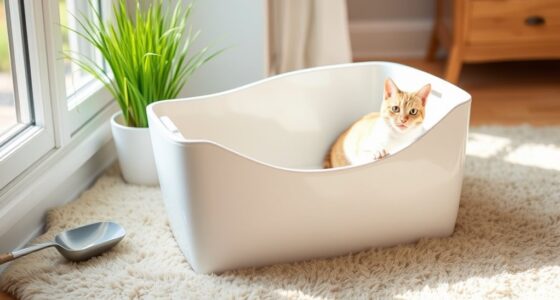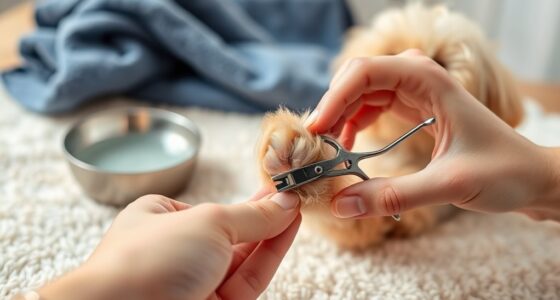To enrich your indoor cat’s life, try creating DIY puzzle feeders using household items like bottles or muffin tins to challenge them mentally. Build creative towers and hideouts from cardboard boxes for climbing and hiding. Incorporate interactive toys, such as laser pointers or hidden treats, to encourage play. Add scents or foraging activities to stimulate their senses. And don’t forget a sturdy window perch or plant-filled space for outdoor observation—discover more ideas to keep your cat happy and engaged.
Key Takeaways
- Create DIY puzzle feeders using household items like bottles or muffin tins to stimulate problem-solving and slow down eating.
- Repurpose cardboard boxes into climbing towers, hideouts, or plush caves to encourage exploration and nesting.
- Use homemade interactive toys such as treat-hiding boxes or laser pointer-based games to promote physical activity and hunting instincts.
- Incorporate scent enrichment with catnip, herbs, or scented items hidden around the home to stimulate olfactory senses.
- Install secure window perches and add safe, non-toxic plants indoors to provide visual stimulation and a calming environment.
DIY Puzzle Feeders to Challenge Your Cat’s Mind
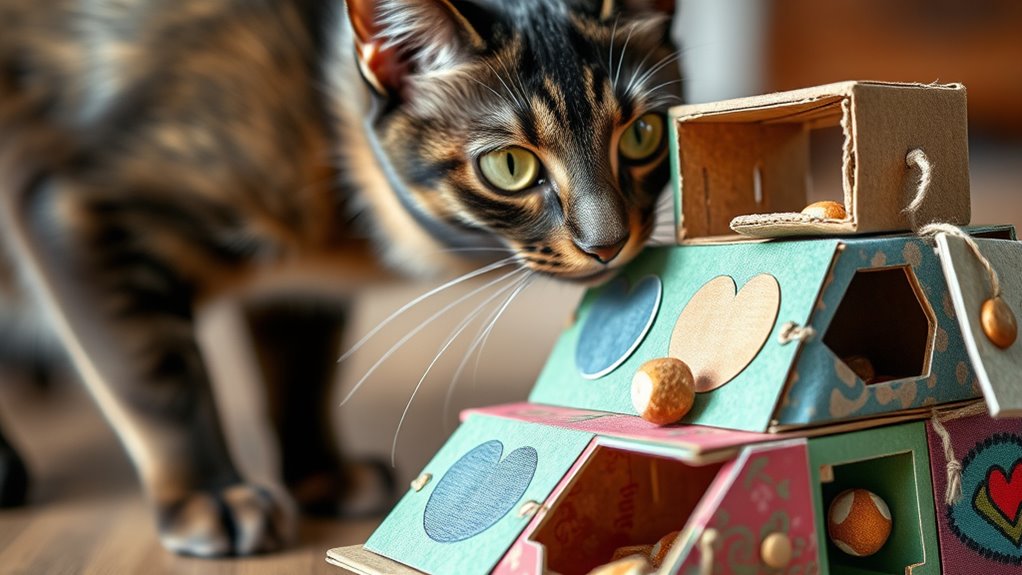
Creating DIY puzzle feeders is a simple way to keep your indoor cat mentally stimulated and engaged. Using cat food puzzles, you can turn mealtime into an enriching activity that challenges your cat’s problem-solving skills. These DIY enrichment tools are easy to assemble with household items like plastic bottles, cardboard boxes, or muffin tins. For example, cut holes into a plastic bottle and fill it with kibble; your cat will enjoy figuring out how to get the food out. Not only does this slow down eating, but it also encourages natural hunting instincts. Regularly rotating different DIY puzzle feeders keeps your cat curious and mentally active. Plus, crafting these feeders gives you a fun, budget-friendly way to promote your cat’s well-being indoors.
Creative Cat Towers and Hideouts From Everyday Items
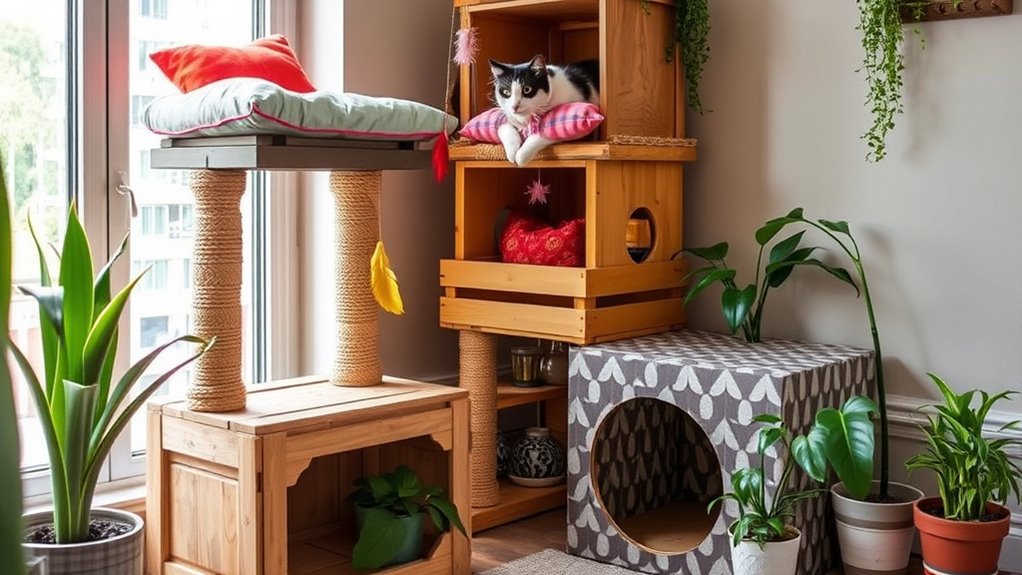
Building on the idea of stimulating your cat’s mind with DIY puzzle feeders, you can also craft engaging spaces for your feline with everyday household items. Repurpose cardboard boxes into cozy cat towers or hideouts, adding platforms or levels for climbing. Attach a simple cat scratcher made from sisal rope to a sturdy base to encourage scratching and play. For a soft, inviting retreat, create plush caves using blankets draped over furniture or stuffed with cushions—perfect for hiding or napping. Use cardboard tubes or baskets to make mini hideouts that satisfy your cat’s natural instincts. These DIY structures provide entertainment, scratching opportunities, and cozy spots, all from items you already have, enriching your indoor environment without breaking the bank.
Interactive Toys and Games You Can Make at Home

Have you ever wondered how to keep your indoor cat mentally stimulated and entertained without spending a lot? You can create simple, DIY interactive toys and games at home. Treat puzzles are an excellent option; hide treats inside a cardboard box or a folded towel, encouraging your cat to problem-solve and find the reward. Laser games are another fun idea—use a handheld laser pointer to dart across the floor or wall, prompting your cat to chase and pounce. You can also make your own laser toy by attaching a small laser pointer to a stick or string, creating unpredictable movements. These activities keep your cat engaged, promote exercise, and stimulate their natural hunting instincts—all with minimal cost and effort. Incorporating interactive play can significantly enhance your cat’s mental and physical well-being.
Engaging Scents and Foraging Activities for Mental Stimulation
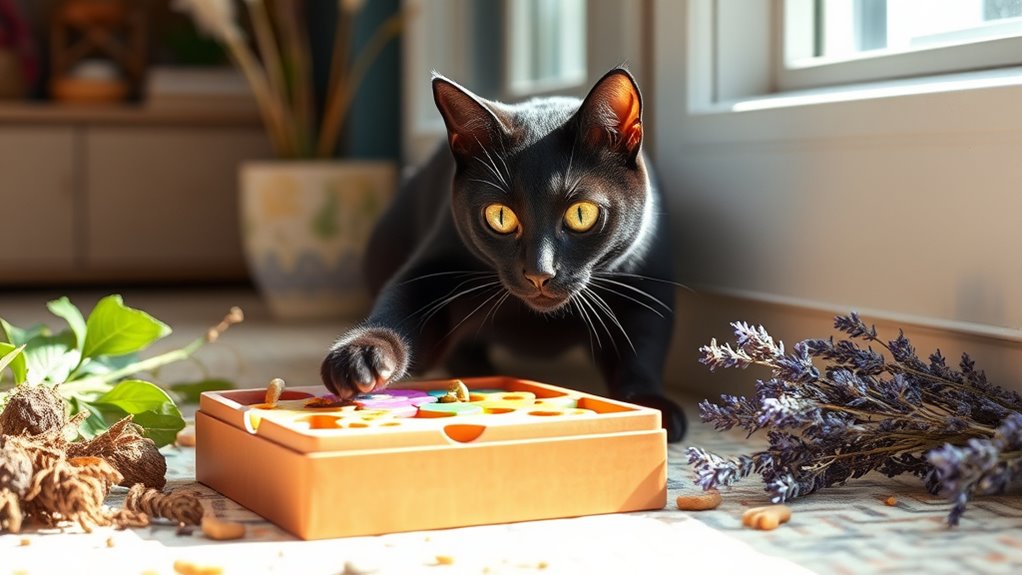
Introducing new scents and foraging activities can considerably enrich your indoor cat’s environment by engaging their senses and natural instincts. Scent enrichment involves using different aromas, like catnip, silver vine, or safe herbal blends, to stimulate your cat’s olfactory senses. You can hide these scents around your home or inside puzzle toys to create a foraging simulation. This encourages your cat to sniff, explore, and hunt, satisfying their natural hunting instincts. Using scent enrichment not only keeps them mentally stimulated but also reduces boredom and stress. Incorporate various textures, scents, and hiding spots to keep the activity fresh and engaging. By doing so, you provide a stimulating environment that promotes curiosity and mental sharpness. Wall organization systems can be an effective way to create designated areas for enrichment activities and keep your space orderly.
Crafting a Cat-Friendly Garden or Window Perch

Creating a cat-friendly garden or window perch transforms a simple space into a stimulating outdoor-inspired environment where your cat can observe, play, and relax. To guarantee safety and enjoyment, consider these steps:
Transform your space into a safe, stimulating outdoor-inspired haven for your cat to observe, play, and relax.
- Choose non-toxic indoor plants safe for cats, avoiding any with toxic indoor plant safety risks.
- Securely install a sturdy window perch or shelves, providing stable access for your feline friend.
- Keep the window clean using gentle window cleaning tips to maintain clear views and prevent streaks that could deter your cat from observing.
- Regularly inspect plants and perch structures for stability, ensuring your cat’s safety during their outdoor-inspired adventures.
- Position the perch away from potential hazards, such as cords or sharp edges, to enhance your cat’s safety and comfort.
Frequently Asked Questions
How Often Should I Rotate My Indoor Cat’s Enrichment Activities?
You should rotate your indoor cat’s enrichment activities every one to two weeks. This rotation schedule keeps things fresh and maintains your cat’s interest. By regularly introducing new toys and activities, you increase activity variety, which prevents boredom and encourages healthy exercise. Pay attention to your cat’s preferences, and adjust the schedule if needed, ensuring they stay engaged and stimulated with a good mix of different enrichment options.
What Safety Precautions Should I Consider With DIY Cat Toys?
When making DIY cat toys, always prioritize cat toy safety by avoiding small parts that could be swallowed and using non-toxic, pet-safe materials. Watch out for DIY material hazards like sharp edges or loose threads that could harm your cat. Regularly check toys for wear and tear, and discard any damaged items. By keeping safety in mind, you guarantee your cat enjoys enriching playtime without risks.
Can Enrichment Activities Help With My Cat’s Behavioral Issues?
Yes, enrichment activities can help with your cat’s behavioral issues by supporting behavioral modification and reducing stress. When you provide engaging toys and activities, your cat stays mentally stimulated and less likely to develop problem behaviors. Regular enrichment creates a calmer environment, helping your cat feel secure. So, investing time in DIY activities can make a noticeable difference in your cat’s overall behavior and emotional well-being.
How Do I Determine Which Enrichment Activities My Cat Prefers?
Imagine your cat’s preferences as a unique garden, each plant representing a different activity. To discover what they love, observe their reactions to various enrichment activities, noting which ones excite or relax them. Pay attention to their cat personality—playful, curious, or reserved—and tailor activities accordingly. Try different toys, puzzles, or textures, and see which ones your cat gravitates toward, helping you create a personalized enrichment routine.
Are There Any Indoor Plants Safe for Cats in a DIY Garden?
Yes, there are several cat-friendly plants you can include in your DIY indoor garden, like cat grass, spider plants, and catnip. Always choose plants with non-toxic plant avoidance to guarantee your feline friend’s safety. Avoid toxic plants such as lilies, poinsettias, and philodendrons. By selecting safe, non-toxic options, you create a beautiful, enriching environment that keeps your cat healthy and happy indoors.
Conclusion
By getting creative with DIY enrichment ideas, you’ll keep your indoor cat happy and mentally stimulated. These activities are more than just fun—they help prevent boredom and strengthen your bond. Remember, a little effort goes a long way; it’s often the small things that make a big difference. Keep exploring new ideas, and you’ll see your feline friend thrive. After all, a well-occupied cat is a happy cat, and a happy cat makes a happy home.



